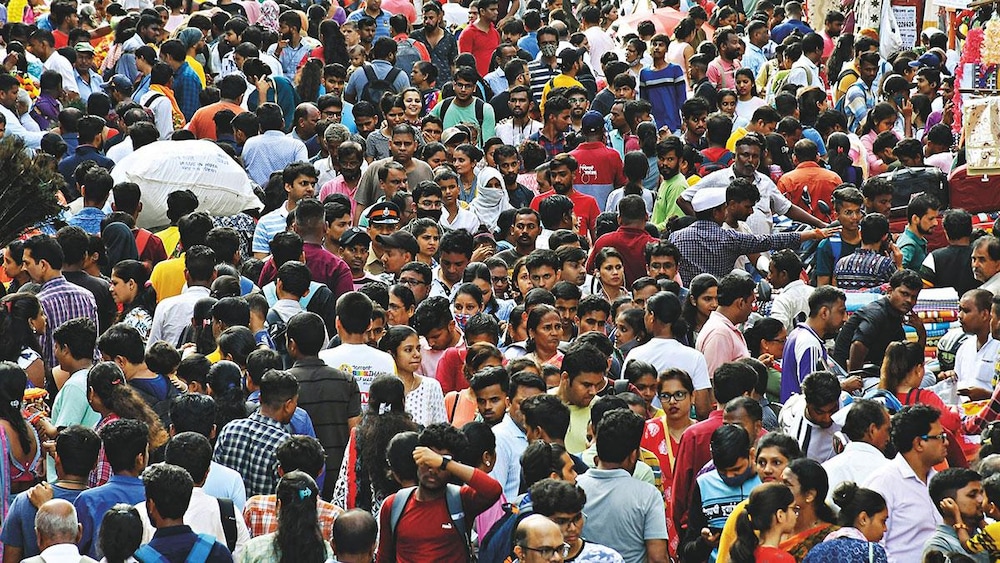
“We need to worry about population explosion.” That message was delivered by PM Narendra Modi from the ramparts of the Red Fort on India’s 73rd Independence Day. He added that the rising population poses various challenges for the country and future generations. Now, the UNPF State of World Population 2023 report has released figures showing India overtaking China to become the world’s most populated country with 1.43 billion people by mid-2023.
“A growing population of this size means additional job creation, creating infrastructure and providing healthcare, education, and social security,” says Arun Singh, Global Chief Economist of Dun & Bradstreet. In that sense, India’s growing population is certainly a challenge. But mitigating its effect is possible only
if the country’s GDP grows robustly on a sustained basis and, consequently, the per capita income.
Per an EY India report, the Indian economy is expected to grow to $26 trillion by 2047, and per capita income is expected to increase sixfold to $15,000 (Rs 12.30 lakh) per annum. What this means is that the numerator (GDP) has to grow at a sustained pace while the denominator (population growth) moderates. This will help the nation manage its resources optimally.
China’s GDP—with its large population—has been growing at an average annual rate of around 7 per cent since the 1980s. Vietnam is another country that has witnessed a growth rate of 6 per cent since the 2000s. Indonesia, Bangladesh, and the Philippines, too, have high growth rates, but their populations are nowhere close to India’s or China’s. Meanwhile India—that has been growing at an average rate of over 5 per cent since the 1990s—has to up its game to support its large and expanding population. Singh says, in order to absorb the rising population into the workforce, India has to grow at a real GDP rate of 10.8 per cent till 2030, 6.5 per cent till 2040, and 4.2 per cent till 2047. “The capital requirement will be $120 trillion in the next 25 years.”
“India’s growing population brings a lot of responsibility for the government and society,” says Madan Sabnavis, Chief Economist of Bank of Baroda. He highlights several challenges, such as a majority of India’s population stuck in lower income groups, migration and overcrowding in urban areas, along with the need to provide social support in terms of education and health services.
In that backdrop, India’s belated move to increase the share of manufacturing—that has been stagnant at around 17-18 per cent—will face huge challenges from Industry 4.0 and automation. In addition, AI-powered tools are threatening to take away jobs, while the forces of anti-globalisation work to impact the free flow of labour. “In India, there will be 1.1 billion people who will be part of the working age group of 15 to 64, by 2047... We are talking about enormous pressure on the labour market. We have to create enough jobs,” says Singh.
India’s population growth is expected to peak around 2060, per projections. Another research published in medical journal Lancet in October 2020, states that India is projected to have the largest working-age population by 2100, followed by Nigeria, China, and the US. “The changing dynamics, with low fertility rates, longer life, and health expectancy, also require the government to rethink their policy as well as spending priorities, as they face lower consumer spending, a less robust workforce, and increasing healthcare needs in the years ahead,” says Radhika Rao, Senior Economist at DBS Group Research.
Experts suggest that one of the priorities should be to improve human development indices. “This would imply action across the value chain—from better medical access from birth, to sufficient nutrition, education, social protection, and improving life expectancy,” says Rao.
They also suggest higher expenditure on education and health. “The centre and states have to work together on this. We need to have a more equitable education system, so that opportunities are similar for
all. While this is difficult given the scale, it is necessary,” says Sabnavis.
He further suggests that municipalities should be empowered to improve rural and urban infrastructure. “At a theoretical level, getting the private sector to run cities will work (though there are constitutional constraints), just like it [the government] has done in airports. There is too much lack of accountability at these levels,” says Sabnavis.
“It’s not just about the willingness; it’s also about the ability of public finances to put money into healthcare and social security issues,” says Singh.
@anandadhikari